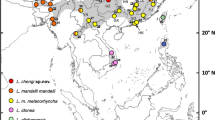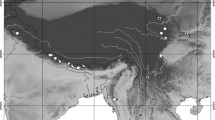Abstract
The great green bush-cricket, Tettigonia viridissima, is at the northern limits of its geographic distribution in the UK and has suffered a significant reduction in population abundance and range over the last 50 years, now being largely confined to the southern UK. This study uses five characters to investigate differences between UK and mainland Western European populations, questioning the possibility that UK populations might represent a distinct species or sub-species and thus deserve special conservation status. Males of T. viridissima from UK, France and Spain were compared using morphometry, flight, male calling song and analysis of mitochondrial DNA sequences. Results suggest morphological differences between UK population samples and continental Europe with the UK samples showing shorter wing length relative to body length than populations in continental Europe. Morphological differences between French and Spanish populations followed a size cline related to latitude with more southerly populations showing larger features. Analysis of male flight distances and calling song showed significant differences with increased flight distance and minimum stridulation following a southerly latitude which correlates with wing length results. No differences consistent with geographical distributions were found in mitochondrial DNA COI sequence alignments. Morphological differences could be due to developmental differences linked to differing temperature clines or a non-adaptive difference caused by the colonisation history of the species. The consequences of morphometric variation on flight function and stridulation in bush-crickets are discussed.






Similar content being viewed by others
References
Alexander RD (1968) Life cycles origins, speciation and related phenomena in crickets. Q Rev Biol 43:1–41
Arak A, Eiriksson T (1992) Choice of singing sites by male bushcrickets (Tettigonia viridissima) in relation to signal propagation. Behav Ecol Sociobiol 30:365–372
Armbruster P, Bradshaw WE, Holzapfel CM (1998) Effects of postglacial range expansion on allozyme and quantitative genetic variation of the pitcher-plant mosquito. Wyeomyia smithii. Evolution 52:1697–1704
Avise JC, Hamrick JL (1994) Conservation genetics: case histories from nature. Kluwer, Massachussetts
Avise JC, Walker D, Johns GC (1998) Speciation durations and pleistocene effects on vertebrate phylogeography. Proc R Soc Lond B 265:1707–1712
Azivedo RBR, James AC, Mccabe J, Partridge L (1998) Latitudinal variation of wing: thorax size ratio and wing-aspect ratio in Drosophila melanogaster. Evolution 52:1353–1362
Blankenhorn WU, Fairbairn DJ (1995) Life history adaptation along a latitudinal cline in the water strider Aquarius remigis (Heteroptera: Gerridae). J Evol Biol 8:21–41
Butlin RK (1998) What do hybrid zones in general, and the Chorthippus parallelus zone in particular, tell us about speciation? In: Howard DJ, Berlocher S (eds) Endless forms: species and speciation. Oxford University Press, New York, pp 367–378
Chung WI (2001) The genic view of the process of speciation. J Evol Biol 14:851–865
Ciplak B (2004) Systematics, phylogeny and biogeography of Anterastes (Orthoptera, Tettigoniidae, Tettigoniinae): evolution within a refugium. Zool Scripta 33:19–44
Clegg SM, Degnan SM, Kikkawa J, Moritz C, Estoup A, Owens IPF (2002) Genetic consequences of sequential founder events by an island-colonizing bird. Proc Natl Acad Sci USA 99:8127–8132
Cooper E (2009) An investigation of factors affecting the distribution and anatomical variation of the Tettigonia viridissima (Tettigoniidae: Orthoptera). Dissertation, University of Plymouth, Plymouth
Cooper SJB, Ibrahim KM, Hewitt GM (1995) Postglacial expansion and genome subdivision in the European grasshopper Chorthippus parallelus. Mol Ecol 4:49–60
Crandall KA, Bininda-Emonds ORP, Mace GM, Wayne RK (2000) Considering evolutionary processes in conservation biology. Trends Ecol Evol 15:290–295
Crouse J, Amorese D (1987) Ethanol precipitation: ammonium acetate as an alternative to sodium acetate. Focus 9(2):3–5
Devon Biodiversity Action Plan (2005) Great green bush cricket http://www.devon.gov.uk/dbap-insect-cricket.pdf. Accessed 8th July 2011
Dudley R (2002) The biomechanics of insect flight: form, function, evolution. Princeton University Press, Princeton
Duijm M (1990) On some song characteristics in Ephippiger (Orthoptera: Tettigonioidae) and their geographic variation. Neth J Zool 40:428–453
Duijm M, Oudman L (1983) Interspecific mating in Ephippiger (Orthoptera: Tettigonioidae). Tijdschr Entomol 126:97–108
Dytham C (2003) Choosing and using statistics—a biologists guide, 2nd edn. Blackwell, Oxford
Ellington CP (1984a) The aerodynamics of hovering insect flight. II. Morphological parameters. Philos Trans R Soc Lond B Biol Sci 305:17–40
Ellington CP (1984b) The aerodynamics of hovering insect flight. III. Kinematics. Philos Trans R Soc Lond B Biol 305:41–78
Ellington CP (1984c) The aerodynamics of hovering insect flight. VI. Lift and power requirements. Philos Trans R Soc Lond B Biol 305:145–181
Excoffier L, Hofer T, Foll M (2009) Detecting loci under selection in a hierarchically structured population. Heredity 103:285–298
Global Biodiversity Information Facility (2010) Occurrence overview map for Tettigonia viridissima. http://www.data.gbif.org/datasets/provider/119. Accessed 8 July 2010
Haes ECM, Harding PT (1997) Atlas of grasshoppers, crickets and allied insects in Britain and Ireland. Institute of Terrestrial Ecology, The Stationery Office, London
Hall TA (1999) BioEdit: a user-friendly biological sequence alignment editor and analysis program for Windows 95/98/NT. Nucl Acids Symp Ser 41:95–98
Hartley JC, Warne AC (1984) Taxonomy of the Ephippiger ephippiger complex (ephippiger, cruciger and cunii) with special reference to the mechanics of copulation. Eos 60:43–54
Hebert PDN, Cywinska A, Ball SL, Dewaard JR (2003) Biological identifications through DNA barcodes. Proc R Soc Lond B 270:313–321
Hewitt GM (1988) Hybrid zones—natural laboratories for evolutionary studies. Trends Ecol Evol 3:158–167
Hewitt GM (1989) The subdivision of species by hybrid zones. In: Otte D, Endler JA (eds) Speciation and its consequences. Sinauer Associates, Sunderland, pp 85–110
Hewitt GM (1996) Some genetic consequences of ice ages, and their role in divergence and speciation. Biol J Linn Soc 58:247–276
Hewitt GM (1999) Post-glacial re-colonization of European biota. Biol J Linn Soc 68:87–112
Hewitt GM (2000) The genetic legacy of the quaternary ice ages. Nature 405:907–913
Hewitt GM (2004) Genetic consequences of climatic oscillations in the quaternary. Phil Trans R Soc Lond B Biol 359:183–195
Hillis DM, Moritz C, Mable BK (1996) Molecular systematics. Sinauer Associates, Sunderland
Holst KT (1986) The Saltatoria (bush-crickets, Crickets and Grasshoppers) of Northern Europe. E.J. Brill/Scandinavian Science Press Ltd, Copenhagen
Joost S, Bonin A, Bruford MW, Despres L, Conord C, Erhardt G, Taberlet P (2007) A spatial analysis method (SAM) to detect candidate loci for selection: towards a landscape genomics approach to adaptation. Mol Ecol 16:3955–3969
Lovette IJ (2005) Glacial cycles and the tempo of avian speciation. Trends Ecol Evol 20:57–59
Lunt DH, Ibrahim KM, Hewitt GM (1998) mt DNA phylogeography and postglacial patterns of subdivision in the Meadow Grasshopper Chorthippus parallelus. Heredity 80:633–641
Marshall JA, Haes ECM (1988) Grasshoppers and allied insects of Great Britain and Ireland. Harley Books, Colchester
Mazaki S, Sugahara T (1992) Photoperiodic control of larval development and wing form in Modicogryllus sp. (Orthoptera: Gryllidae)
Merrick MJ, Smith RJ (2003) Temperature regulation in burying beetles (Nicrophorus spp.: Coleoptera: Silphidae): effects of body size, morphology and environmental temperature. J Exp Biol 207:723–733
Montealegre F, Jonsson T, Robert D (2011) Sound radiation and wing mechanics in stridulating field crickets (Orthoptera: Gryllidae). J Exp Biol 214:2105–2117
Moritz C (1994) Application of mitochondrial DNA analysis in conservation: a critical review. Mol Ecol 3:401–411
Moulton MJ, Song H, Whiting MF (2010) DNA Barcoding assessing the effects of primer specificity on eliminating numt coamplification in DNA barcoding: a case study from Orthoptera (Arthropoda: Insecta). Mol Ecol Resour 10:615–627
Mousseau TA (1997) Ectotherms follow the converse to Bergmann’s Rule. Evolution 51:630–632
Mousseau TA, Roff DA (1989) Adaptation to seasonality in a cricket: patterns of phenotypic and genotypic variation in body size and diapause expression along a cline in season length. Evolution 43:1483–1496
Nei M, Kumar S (2000) Molecular evolution and phylogenetics. Oxford University Press, New York
Nijhout HF, Emlen J (1998) Competition among body parts in the development and evolution of insect morphology. Evolution 95:3685–3689
Nylin S, Svard L (1991) Latitudinal patterns in the size of European butterflies. Hol Ecol 14:192–202
Ouborg NJ, Pertoldi C, Loeschcke V, Bijlsma R(K), Hedrick PW (2010) Conservation genetics in transition to conservation genomics. Trends Genet 26(4):177–187
Oudman L, Landman W, Duijm W (1989) Genetic distance in the genus Ephippiger (Orthoptera: Tettigonioidae)—a reconnaissance. Tijdschr Entomol 132:177–181
Oudman L, Duijm M, Landman W (1990) Morphological and allozyme variation in the Ephippiger ephippiger complex (Orthoptera: Tettigonioidae). Neth J Zool 40:454–483
Parajulee NM, Shrestha BR (2007) Morphometry of Lygus bugs: implications in pest management. Texas Agricultural Experiment Station, Texas
Pettersson L (1999) BatSound. Real-time spectrogram sound analysis software for Windows 95. Pettersson Elektronik AB, Uppsala: Sweden
Reed SC, Williams CM, Chadwick LE (1942) Frequency of wing-beat as a character for separating species races and geographic varieties of Drosophila. Genetics 27:349–361
Riede K (1998) Acoustic monitoring of orthoptera and its potential for conservation. J Insect Conserv 2(3–4):217–223
Ritchie MG (2000) The inheritance of female preference functions in a mate recognition system. Proc R Soc Lond B 267:327–332
Ritchie MG, Kidd DM, Gleason JM (2001) Mitochondrial DNA variation and GIS analysis confirm a secondary origin of geographical variation in the bushcricket Ephippiger ephippiger (Orthoptera: Tettigonioidea), and resurrect two subspecies. Mol Ecol 10:603–611
Rubinoff D (2005) Utility of mitochondrial DNA barcodes in species conservation. Conserv Biol 20(4):1026–1033
Saldamando CI, Miyaguchi S, Tatsuta H, Kishino H, Bridle JR, Butlin RK (2005) Inheritance of song and stridulatory peg number divergence between Chorthippus brunneus and C. jacobsi, two naturally hybridizing grasshopper species (Orthoptera: Acrididae). J Exp Biol 18(3):703–712
Schuch S, Bock J, Leuschner C, Schaefer M, Wesche K (2011) Minor changes in orthopteran assemblages of Central European protected dry grasslands during the last 40 years. J Insect Conserv. doi:10.1007/s10841-011-9379-6
Schul J, Von Helverson D, Weber T (1998) Selective phonotaxix in Tettigonia cantans and T. viridissima in song recognition and discrimination. J Comp Physiol A 182:687–694
Seenivasagan T, Sharma KR, Shrivastava A, Parashar BD, Pant SC, Prakash S (2009) Surface morphology and morphometric analysis of sensilla of Asian tiger mosquito. Aedes albopictus (Skuse): an SEM investigation. J Vector Borne Dis 46:125–135
Sheffield NC, Hiatt KD, Valentine MC, Song H, Whiting MF (2010) Mitochondrial genomics in Orthoptera using MOSAS. Mitochondrial DNA 21(3–4):87–104
Spooner LJ, Ritchie MG (2006) An unusual phylogeography in the bushcricket Ephippiger ephippiger from southern France. Heredity 97:398–408
Taberlet P, Fumagalli L, Wust-Saucy A, Cosson J (1998) Comparative phylogeography and postglacial colonisation routes in Europe. Mol Ecol 7:453–464
Tamura K, Dudley J, Nei M, Kumar S (2007) MEGA4: molecular evolutionary genetics analysis (MEGA) software version 4.0. Mol Biol Evol 24:1596–1599
Telfer MG, Hassall M (1999) Ecotypic differentiation in the grasshopper Chorthippus brunneus: life history varies in relation to climate. Oecologia 121:245–254
Thompson JD, Higgins DG, Gibson TJ (1994) CLUSTAL W: improving the sensitivity of progressive multiple sequence alignment through sequence weighting, position-specific gap penalties and weight matrix choice. Nucleic Acids Res 22(22):4673–4680
Tregenza T, Pritchard VL, Butlin RK (2000) Patterns of trait divergence between populations of the Meadow Grasshopper Chorthippus Parallelus. Evolution 54(2):574–585
Tregenza T, Pritchard VL, Butlin RK (2002) The origins of postmating reproductive isolation: testing hypotheses in the grasshopper Chorthippus parellus. Popul Ecol 44:137–144
Waples RS (1991) Pacific salmon, Oncorhynchus spp., and the definition of “species” under the Endangered Species Act. Mar Fish Rev 53:11–22
Weis-Fogh T (1973) Quick estimates of flight fitness in hovering animals, including novel mechanisms for lift production. J Evol Biol 59:169–230
Wiens JJ (2004) The role of morphological data in phylogeny reconstruction. Syst Biol 53:653–661
Zelditch ML, Swiderski DL, Sheets HD, Fink WL (2004) Geometric morphometrics for biologists. Elsevier, London
Zhou Z, Huang Y, Shi F, Ye H (2009) The complete mitochondrial genome of Deracantha onos (Orthoptera: Bradyporidae). Mol Biol Rep 36:7–12
Author information
Authors and Affiliations
Corresponding author
Rights and permissions
About this article
Cite this article
Cooper, E.M., Lunt, P.H., Ellis, J.S. et al. Biogeographical patterns of variation in Western European populations of the great green bush-cricket (Tettigonia viridissima; Orthoptera Tettigoniidae). J Insect Conserv 17, 431–440 (2013). https://doi.org/10.1007/s10841-012-9525-9
Received:
Accepted:
Published:
Issue Date:
DOI: https://doi.org/10.1007/s10841-012-9525-9




